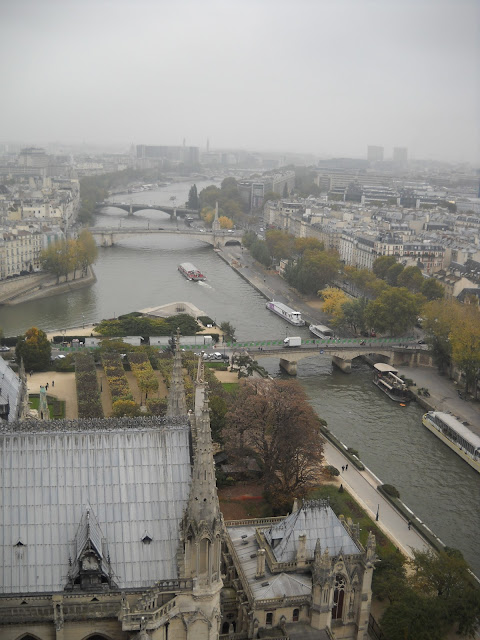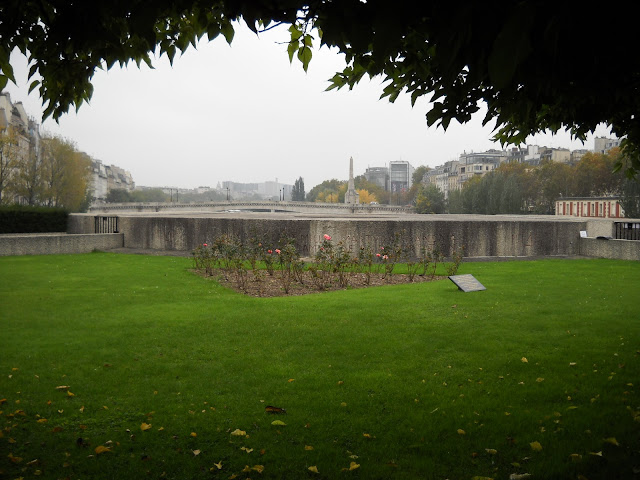The Wednesday after I got back to Paris from Venice, I unexpectedly found myself with almost the whole day free. My three hour creative writing class that day had been broken up into fifteen minute one-on-one conferences (that class's version of a midterm). Mine wasn't until four in the afternoon, so I decided to crack open my Rick Steves "Best of Europe" guidebook and take myself on roughly the first two-thirds of his "Historic Paris" walk. This was largely to remedy the tragic fact that I had lived in Paris nearly two months and hadn't yet been to Notre Dame cathedral.
Problem solved.
The cathedral was begun in 1165, but wasn't completed until about 1345. It's considered one of the finest examples of Gothic architecture in Europe, and was actually one of the first buildings to ever use flying buttresses to keep the walls of the nave and choir from collapsing outward under their own weight. While a Roman Catholic cathedral, it was actually turned into a secular place of "worship" for the atheistic "Cult of Reason" during the French Revolution, and was afterwards briefly as a place of worship for the "Cult of the Supreme Being," a deistic religious thought system developed by Robespierre. Today the cathedral is back to being devoted to Roman Catholicism and is, literally, the seat of the Archbishop of Paris (his chair is near the altar of the church and is called a "cathedra", which is why Notre Dame is a "cathedral").
Just about anyone can recognize the general facade of the cathedral with its two belltowers, but once you get right up close to it then you can really see how extraordinary the architecture is. Look at that line of saints that stretches from one end of the facade all the way to the other. (Many of them were beheaded during the French Revolution, as they were mistaken for old kings of France.) Above them is the outside of the famous "Rose Window" of stained glass, with a statue of the Virgin Mary ("Notre Dame" means "Our Lady", i.e., the Virgin) right up there in the middle.
There are three giant gothic archways over the three main front doorways into the cathedral.
I mean, no wonder it took them almost 200 years to build this place; look at how many individual sculptures fill just one of these arches!
I got a bit obsessed with the archways...
One of the nice things about Notre Dame is that it's free to go inside the cathedral. But for a small fee you can actually climb all the way up to the base of the north belltower, walk all the way across the front of the cathedral and then climb the rest of the way to the very top of the south tower. It was a rather gray day when I did this, but the views are pretty spectacular nonetheless:
View from the base of the north tower.
The famous "Bored Gargoyle."
The entrance into the south tower. This isn't the entrance into the south tower staircase where you can climb up to the top, but into the tower itself. I took a picture of the doorways because even though its hard to tell without any reference of scale here, these openings are tiny. Maybe only about four feet tall.
The reason you go into the south tower is to go up a rickety, extremely narrow wooden stairway to see this:
This is Emmanuel, Notre Dame's biggest bell. He weighs over 13 tons.
After stopping by to say hello to Emmanuel I trekked up the south tower staircase (from street level to the top of the tower it's over 400 steps).
The view out over the nave and choir of the cathedral.
Looking eastward down the river Seine.
Looking slightly northeast to the other half of the river on the north side of the Ile de la Cite on which Notre Dame is built (and where Paris was originally founded).
Looking south across the river to an adorable little garden near a church (more pictures of that at the end!).
Looking out straight west from the front of Notre Dame towards the Palais de Justice (the building with the big dome) and St. Chapelle (the church to the left of the Palais).
If you look very carefully ALLLLL the way to the right you can see the very faint outline of the Eiffel Tower.
After climbing all the way down again, I finally went into the cathedral itself.
I have to say right up front that I am not, shall we say, a religious person. In any way, shape, or form. But guys, I love churches. I love them (and cathedrals, basilicas, shrines, mosques, temples, you name it). They are--and are full of--some of the most beautiful works of art ever created. And whenever I visit one, especially a house of worship on the scale of Notre Dame, I am always dumbstruck by the level of devotion people must have to their deity of choice to construct such a monument to that deity. Even with my personal feelings on religion aside, places like Notre Dame represent a level of faith that I will not ever be able to wrap my head around. But oh man, are they wonderful to admire.
Seriously guys, how do you build something like this without modern engineering? Or a modern understanding of mathematics? Or, you know, a crane? And not only that, but how do you build it and then have the completed structure be able to stand for almost 700 years?
A little miniature of what it may have looked like with all of the little peasant laborers when they were just starting construction.
The Rose Window over the entrance.
My walk then led me around the side and back of the cathedral where there's a lovely little park on the cathedral grounds.
Each end of the transept gets its own rose window too.
It feels big when you're walking around the inside of the cathedral, but for me it wasn't until I started walking around the outside that I realized how huge the place is.
A pretty gothic fountain in the middle of the park directly behind the cathedral.
Directly across the street from that park I reached the edge of the Ile de la Cite. On the tip of the island is the Deportation Memorial, sunken into the ground near the river. It is dedicated to the 200,000 people deported from Vichy France during the Nazi occupation to concentration camps.
I walked down the access stairs at the far right and entered into an enclosed stone courtyard. Right under this grassy area is a very, very narrow passageway that leads to this little space:
An eternal flame burns in the middle of the circular plaque. To either side of this room are identical stone rooms designed to look and feel like prison cells. Translated into English the inscription around the edge of the plaque reads: "They descended into the mouth of the earth and they did not return."
The passageway leading out into the courtyard.
Lit from below, the walls of this hallway are covered in 200,000 individual crystals representing each one of the deportees. The bar in the exact center covers it up in this picture, but there is a bright light shining at the opposite end. On the walls of this room and the two cells are written, in French, the words of the last stanza of a poem composed by Robert Desnos, who was a French Resistance fighter and a deportee, called "The Heart That Hated War." In English it reads:
It was very moving to see and experience, and slightly creepy as well, since I was the only person there. (I'm rather glad that I only found out AFTER I'd visited that the memorial is built on the spot of a former morgue.)
After that I crossed the bridge to the Left Bank, which like any and all bridges in Paris with chain-link in the railings is covered in padlocks:
I wandered down towards that little garden I'd seen earlier from the top of Notre Dame. Turns out its name is the Square Rene-Vivani, and it's adjacent to the Church of Sainte Julien-le-Pauvre:
Right next to the church is a rather odd-looking tree:
This is Jean, and he is the oldest tree in Paris. He's a locust tree believed to have been planted by a man named Jean Robin in 1601! He lost his upper branches when a shell exploded nearby in WWI and is now supported by two concrete crutches, but continues to bloom every year.
A cute little street. I was intrigued at how the buildings bow outward ever so slightly...
I finally visited the most famous English bookstore in Paris: Shakespeare and Company!
Finally I walked over to the other island in the middle of the Seine, the Ile St. Louis, where I met up with a friend at the Berthillon tearoom. Berthillon is an extremely popular gourmet ice cream brand in Paris. I had one of the most delicious ice cream sundaes of my life (and the most delicious tea, for that matter). It involved raspberry sorbet, vanilla ice cream, whipped cream, raspberry sauce, chopped pistachios, and a WHOLE PEACH. Worth every euro. All twelve of them...






















































No comments:
Post a Comment